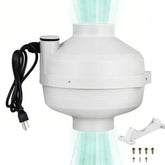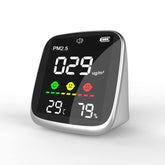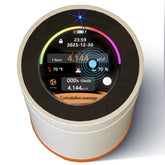What should i do If Too Much Carbon Dioxide (CO2) Inside My Home
Carbon dioxide (CO2) is a natural part of the air we breathe, but when levels rise too high indoors, it can negatively impact your health and comfort. High CO2 concentrations are often a sign of poor ventilation and can lead to symptoms like headaches, dizziness, and fatigue. In this blog, we’ll explore how to identify, measure, and reduce CO2 levels in your home, along with long-term solutions to maintain a healthy indoor environment.
A. Importance of Monitoring CO2 Levels
CO2 is a byproduct of human respiration and combustion processes. While outdoor CO2 levels are typically around 400 parts per million (ppm), indoor levels can rise significantly without proper ventilation. Monitoring CO2 levels is essential to ensure a safe and comfortable living environment.
B. Health Effects of High CO2 Concentrations
-
Short-term Symptoms: Headaches, dizziness, fatigue, and difficulty concentrating.
-
Long-term Risks: Prolonged exposure to high CO2 levels can lead to cognitive decline and respiratory issues.
C. Common Sources of Elevated CO2 in Homes
-
Poor ventilation.
-
Overcrowded spaces.
-
Combustion appliances like gas stoves, heaters, and fireplaces.
Signs of High CO2 Levels
A. Physical Symptoms in Occupants
If you or your family members frequently experience headaches, dizziness, or fatigue, it could be a sign of high CO2 levels.
B. Stuffy or Stale Air
A stuffy or stale feeling in your home often indicates inadequate ventilation and elevated CO2 levels.
C. Poor Ventilation Indicators
-
Condensation on windows.
-
Lingering odors.
-
Excessive humidity.
How to Measure CO2 Levels
A. Using a CO2 Monitor
-
Features to Look For: Choose a monitor that measures CO2 levels accurately and provides real-time readings.
-
Ideal CO2 Levels: Aim for 400-1,000 ppm. Levels above 1,000 ppm can cause discomfort, and levels above 2,000 ppm are considered unhealthy.
-
How to Interpret Readings: Regularly check the monitor and take action if levels exceed recommended thresholds.
B. Professional Testing
-
When to Call an Expert: If you suspect persistent high CO2 levels or have health concerns.
-
What to Expect During Testing: Professionals use advanced equipment to assess CO2 levels and identify sources of poor ventilation.
Immediate Actions to Reduce CO2 Levels
A. Increase Ventilation
-
Open Windows and Doors: Allow fresh air to circulate and dilute CO2 concentrations.
-
Use Exhaust Fans: Turn on fans in kitchens and bathrooms to remove stale air.
B. Limit Occupancy in Small Spaces
-
Avoid Crowding in Rooms: Reduce the number of people in small or poorly ventilated areas.
-
Take Breaks in Well-Ventilated Areas: Spend time outdoors or in rooms with better airflow.
C. Turn Off Combustion Appliances
-
Avoid Using Gas Stoves, Heaters, or Fireplaces: These appliances release CO2 and other pollutants.
-
Ensure Proper Ventilation When Using These Appliances: Always use exhaust fans or open windows.
Long-Term Solutions to Prevent High CO2 Levels
A. Improve Home Ventilation
-
Install Mechanical Ventilation Systems: Heat Recovery Ventilators (HRVs) and Energy Recovery Ventilators (ERVs) can improve airflow while maintaining energy efficiency.
-
Regularly Maintain HVAC Systems: Clean filters and ducts to ensure optimal performance.
B. Use Air Purifiers with CO2 Sensors
-
Choose Models with Real-Time Monitoring: Some air purifiers can measure CO2 levels and adjust settings accordingly.
-
Ensure Proper Placement: Position purifiers in areas with poor ventilation for maximum effectiveness.
C. Incorporate Houseplants
-
Plants That Absorb CO2: Snake plants, pothos, and peace lilies can help reduce CO2 levels.
-
Limitations of Plants: While beneficial, plants alone cannot significantly lower high CO2 concentrations.
D. Seal and Insulate Properly
-
Balance Between Energy Efficiency and Ventilation: Ensure your home is well-insulated but not overly sealed.
-
Avoid Over-Sealing Living Spaces: Allow for natural airflow to prevent CO2 buildup.
Preventive Measures
A. Regularly Monitor CO2 Levels
-
Set Up Alerts on CO2 Monitors: Receive notifications when levels exceed safe thresholds.
-
Check Levels During Different Times of the Day: Monitor fluctuations and identify patterns.
B. Educate Household Members
-
Recognize Symptoms of High CO2: Teach your family to identify signs like headaches and fatigue.
-
Encourage Proper Ventilation Habits: Promote practices like opening windows and using exhaust fans.
C. Avoid Over-Reliance on Combustion Appliances
-
Switch to Electric Alternatives: Use electric stoves and heaters where possible.
-
Ensure Proper Maintenance of Gas Appliances: Regularly inspect and service gas-powered devices.
When to Seek Professional Help
A. Persistent High CO2 Levels Despite Efforts
If CO2 levels remain high despite your efforts, consult an HVAC professional to assess your home’s ventilation system.
B. Suspected Issues with HVAC Systems
A malfunctioning HVAC system can contribute to poor air quality. Have it inspected and repaired if necessary.
C. Health Concerns Related to Indoor Air Quality
If you or your family members experience persistent health issues, seek medical advice and consider professional air quality testing.
High CO2 levels in your home can negatively impact your health and comfort, but with the right tools and strategies, you can effectively manage and reduce them. Start by monitoring CO2 levels with a reliable device, improve ventilation, and adopt long-term solutions like mechanical ventilation systems and air purifiers. By taking proactive measures, you can create a healthier and more comfortable living environment for you and your family.
By following these steps, you can ensure that your home’s CO2 levels remain within safe limits, promoting better health and well-being for everyone. Don’t wait—take action today to breathe easier and live healthier!









Leave a comment
All blog comments are checked prior to publishing